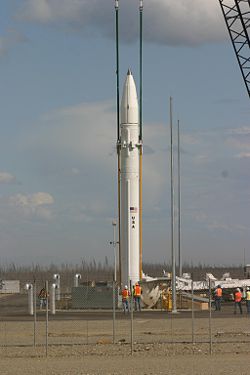
Back صواريخ مضادة للصواريخ الباليستية Arabic Antiballistik raket Azerbaijani প্রতিনিক্ষেপী ক্ষেপণাস্ত্র Bengali/Bangla Míssil antibalístic Catalan مووشەکی دژە بالیستیکی CKB Anti-Ballistic Missile German Misil antibalístico Spanish موشک ضدبالیستیک Persian Ballististen ohjusten torjuntaohjus Finnish Missile antibalistique French

An anti-ballistic missile (ABM) is a surface-to-air missile designed to destroy in-flight ballistic missiles. They achieve this explosively (chemical or nuclear), or via hit-to-kill kinetic vehicles, which may also have self-maneuvering.
Tactical systems are widely deployed to counter short and intermediate-range ballistic missiles that carry conventional warheads.
Strategic systems, deployed by the United States, Russia, and Israel, are capable of intercepting intercontinental ballistic missiles, typically used to carry strategic nuclear warheads. During the Cold War, the 1972 ABM Treaty limited the nuclear arms race; excessive ICBM production would have been favoured to overwhelm ABM systems. Of the modern strategic ABM systems, only Russia's are themselves armed with nuclear warheads.[1]
- ^ Kristensen, Hans M.; Korda, Matt; Johns, Eliana; Knight, Mackenzie (3 March 2024). "Russian nuclear weapons, 2024". Bulletin of the Atomic Scientists. 80 (2): 118–145. doi:10.1080/00963402.2024.2314437. ISSN 0096-3402. Retrieved 20 March 2025.
© MMXXIII Rich X Search. We shall prevail. All rights reserved. Rich X Search